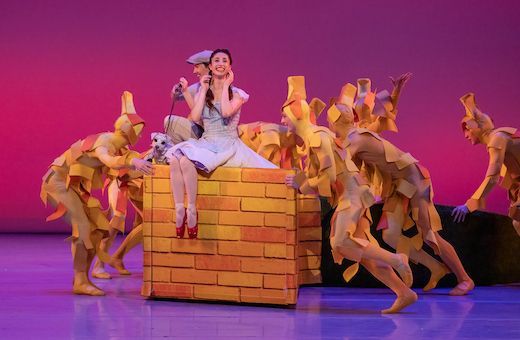The Wizard of Oz is in its second run here at the Kansas City Ballet after debuting back in 2018, and it is still as fresh a take on this beloved local tale as ever. I first followed Septime Webre when he was Director of the Washington Ballet, and I find that his greatest strength as a choreographer is in communicating unabashed, communal joy. Sheer fun is his primary dance language, and therefore we too have fun. Always explicitly close to his own childhood in a large family (he recounts spending a whole summer with his siblings re-costuming a whole suite of marionettes to perform The Wizard, in a way that very much makes them sound like the Von Trapps), there is still something of the child about his capacity to play. Here he plays cheekily, deliciously and very successfully with dance, musical and visual idioms.

The visual is enhanced by Liz Vandal’s costumes, projections by Aaron Rhyne, puppetry by Nicholas Mahon and sets by Michael Raiford, and the gorgeous circus of colour and event they imprint upon our minds. The Munchkins look like Renaissance court jesters but with all sorts of contemporary, psychedelic twists; Scarecrow, droll, knockabout Cameron Thomas, borrows from a Carnaby Street punk idiom, and Tinman (neatly danced by Lamin Pereira) something of a Steampunk. The Yellow Brick Road is danced into being by wittily nicknamed Roadies, covered in jags and slashings, yellow and orange bricks. Webre’s road would come alive, wouldn’t it? Oz is outrageously glamtastic, part emerald discotheque, part 1930s chorus line at the Radio City Music Hall. We wonder idly why Dorothy would want to return to Kansas at all and hoe-down dancing?
Webre’s partnership with Matthew Pierce on the score is brilliant, and nods to 1920s Big Band, 1950s Cool Jazz, 70s Glam Rock and Disco, as well as 1980s New Wave. And while we are never in doubt as to the fact that it is classical ballet we are seeing, Webre and Pierce are entirely comfortable with the comic possibilities of integrating less scripted forms. After all, we aren’t in Kansas anymore. There are lots of fun, dead-pan, deflationary ends, as ballet trails off into whimsy, nonsense or just plain goofiness. And who could fail to be charmed by the lovely touches of musical punctuation for example in oiling the Tin Man, when the strings played col legno?
There is also something of Webre’s big family background visible in his tendency to fill the stage. Nobody is alone for very long in a Webre ballet, it seems; it is very much the case of the more the merrier, and children are nearly always along for the jolly (here as adorable grasshoppers and poppy seeds). Given the busy-ness of his scene scapes, interiority is not a hallmark, and we don’t, for instance, glimpse Dorothy, solo, dancing out her longing for home. Is this a weakness? I’m ambivalent. On the one hand, it might slow down Webre’s whirlwind sense of pace of the post-tornado dream world. On the other, I’d like to see Amanda DeVenuta’s range more, and perhaps the long drowsy poppy scene or some such could be edited to allow time for her to come forward as a reflective individual, as someone whose dream makes her long for a grounded sense of reality. But DeVenuta is a wonderfully ingénue Dorothy, elegance and skittishness combined in what is a most attractive characterisation. This time, I noticed with pleasure the repetition of a second position of her feet earlier on, a position that she makes slightly gawkier than the traditional classical stance, indicating both naivety and openness to what may happen. By the end, when she knows what she wants, her feet – in ruby slippers – are grounded in the classical dancer’s first. She is ready to come home.
Danielle Fu is an impressively angular Miss Gulch/Wicked Witch, but evil has no real power in Webre’s world, and the jazzy element in some of her music reminds us that she is a caricature who does not stand a chance, even alongside her sadomasochistic henchmen and women wielding whips. She does end on a whimper rather than a bang, in a way that seems a little damp.
“If you really, really enjoyed it,” I whispered, as the curtains fell, to my seven-year old companion who was attending her first full-length evening performance, “you can stand in ovation. I never do because I’m reviewing.” I noticed she was among the first to rise. Outside the theatre, afterwards, a little anxiously: “And the witch, she curtsied at the end and seemed quite nice... she isn’t really bad, is she... in real life I mean?” We’re right on track with the theatrical suspension of disbelief.


